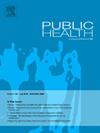对英国COVID-19公共卫生政策“屏蔽”的评估:一项相关数据匹配队列研究的结果
IF 3.9
3区 医学
Q1 PUBLIC, ENVIRONMENTAL & OCCUPATIONAL HEALTH
引用次数: 0
摘要
目的评估英国在2019冠状病毒病大流行期间引入的屏蔽措施的相关结果,以保护受伤害风险最高的人群。研究设计来自英国威尔士人口匹配队列的关联数据和问卷调查。方法:我们比较了被确定为屏蔽者(n = 123,293)和比较者(n = 120,997)之间的个体水平相关常规和自我报告的结果,这些结果与年龄、性别和以前的卫生服务利用情况相匹配。我们向每个队列中随机抽取的1500人发送了调查问卷。结果1年后,屏蔽人群感染SARS-CoV-2的比例为6.1%,而匹配人群为6.2%(调整优势比[AOR] 0.970;95%置信区间[CI] 0.937 ~ 1.004)。疑似医疗保健相关感染在受保护人群中更有可能发生(1.1% vs 0.6%;优势1·678;95%可信区间为1.529 ~ 1.842)。全因死亡率和COVID-19相关死亡率在屏蔽队列中更高(7.0% vs 3.5%;优势2·280;95% CI 2.190 ~ 2.374;1.1% vs 0.8%;优势1·430;95% CI分别为1.308 ~ 1.563)。约1/3完成问卷调查(n = 1015), 752例(屏蔽:n = 411;匹配:n = 341)。受保护的受访者表示身体和心理健康状况较差(SF12 PCS差异:−3·752;95% CI -4·823 - 2·682;SF12 MCS差值:−1·217;95% CI -2·580 ~ 0·145)。他们更有可能严格避免接触;呆在家里;害怕出门;外出购物、休闲或旅游的可能性也更小。结论没有证据表明屏蔽对SARS-CoV-2感染或COVID-19相关死亡率、医院获得性感染率增加和自我隔离增加有保护作用。在未来大流行期间,只有在采取有效措施减少卫生保健相关感染的同时,才应考虑采取防护措施。本文章由计算机程序翻译,如有差异,请以英文原文为准。
Evaluation of the UK's COVID-19 public health policy “Shielding: Results of a linked data matched cohort study
Objective
To assess outcomes associated with shielding, introduced during the COVID-19 pandemic across the UK to protect those at highest risk of harm.
Study design
Linked data and questionnaires in matched cohorts from the population of Wales, UK.
Methods
We compared individual-level linked routine and self-reported outcomes between people identified for shielding (n = 123,293) and comparators (n = 120,997) matched by age, sex, and previous health service utilisation. We sent questionnaires to 1500 randomly sampled people in each cohort.
Results
At one year 6·1 % of shielded people had contracted SARS-CoV-2 compared to 6·2 % in the matched cohort (Adjusted Odds Ratio [AOR] 0·970; 95 % confidence interval [CI] 0·937 to 1·004). Suspected healthcare associated infections were more likely in shielded people (1·1 % vs 0·6 %; AOR 1·678; 95 % CI 1·529 to 1·842). All-cause and COVID-19 related deaths were higher in the shielded cohort (7·0 % vs 3·5 %; AOR 2·280; 95 % CI 2·190 to 2·374; and 1·1 % vs 0·8 %; AOR 1·430; 95 % CI 1·308 to 1·563, respectively).
About 1/3 completed questionnaires (n = 1015), with linkage possible in 752 cases (shielded: n = 411; matched: n = 341). Shielded respondents reported lower physical and mental health (SF12 PCS difference: −3·752; 95 % CI -4·823 to −2·682; SF12 MCS difference: −1·217; 95 % CI -2·580 to 0·145). They were more likely to have strictly avoided contact; stayed at home; felt scared to go outside; and were less likely to have gone out for shopping, leisure or travel.
Conclusion
We found no evidence of a protective effect of shielding on SARS-CoV-2 infections or COVID-19 related mortality, an increased rate of hospital acquired infections and increased self-isolation. Shielding during a future pandemic should only be considered alongside effective measures to reduce healthcare associated infections.
求助全文
通过发布文献求助,成功后即可免费获取论文全文。
去求助
来源期刊

Public Health
医学-公共卫生、环境卫生与职业卫生
CiteScore
7.60
自引率
0.00%
发文量
280
审稿时长
37 days
期刊介绍:
Public Health is an international, multidisciplinary peer-reviewed journal. It publishes original papers, reviews and short reports on all aspects of the science, philosophy, and practice of public health.
 求助内容:
求助内容: 应助结果提醒方式:
应助结果提醒方式:


